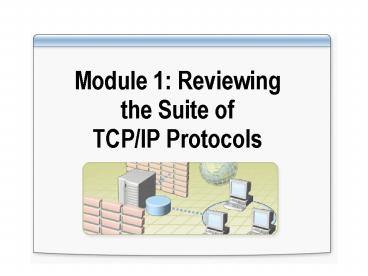Module 1: Reviewing the Suite of TCP/IP Protocols - PowerPoint PPT Presentation
1 / 21
Title:
Module 1: Reviewing the Suite of TCP/IP Protocols
Description:
Each layer has a defined networking function ... Decodes the packets in the language of the individual protocols. Compiles network statistics ... – PowerPoint PPT presentation
Number of Views:65
Avg rating:3.0/5.0
Title: Module 1: Reviewing the Suite of TCP/IP Protocols
1
Module 1 Reviewing the Suite of TCP/IP
Protocols
2
Overview
- Overview of the OSI Model
- Overview of the TCP/IP Protocol Suite
- Viewing Frames Using Network Monitor
3
Lesson Overview of the OSI Model
- What Is the OSI Model?
- The Layers of the OSI Model
4
What Is the OSI Model?
- In the OSI model
- Each layer has a defined networking function
- Each layer communicates with the layer above and
below it - Layer seven provides services for programs to
gain access to the network - Layers one and two define the networks physical
media and related tasks
7
6
5
4
3
2
1
5
Multimedia The Layers of the OSI Model
6
Practice Putting the Layers of the OSI Model in
Order
In this practice, you will put the layers of the
OSI model in their correct order
7
Lesson Overview of the TCP/IP Protocol Suite
- Why Do I Need to Know About TCP/IP?
- What Is the Architecture of the TCP/IP Protocol
Suite? - How Does the TCP/IP Model Relate to the OSI
Model? - How an IP Packet Moves Through the Suite of
TCP/IP Protocols
8
Multimedia Why Do I Need to Know About TCP/IP?
- You need to understand the addressing scheme of
your network to correctly configure client
computers to access it using TCP/IP - You need to know the locations of the windows
where you enter the TCP/IP information - You must be able to find the TCP/IP information
that you use to configure client computers
9
What Is the Architecture of the TCP/IP Protocol
Suite?
TCP/IP Protocol Suite
Application
HTTP
FTP
SMTP
DNS
RIP
SNMP
Transport
IP
Internet
ARP
Link
10
How Does the TCP/IP Model Relate to the OSI Model?
TCP/IP Protocol Suite
TCP/IP
OSI
Application
Application
HTTP
FTP
SMTP
DNS
RIP
SNMP
Presentation
Session
TCP
UDP
Transport
Transport
Network
Internet
IGMP
ICMP
IP
ARP
Link
Data-Link
Physical
11
Multimedia How an IP Packet Moves Through the
Suite of TCP/IP Protocols
- The Four Layers of the TCP/IP Protocol Suite
- Application
- Transport
- Internet
- Link
12
Practice Associating the Protocols and Layers of
the TCP/IP Model
In this practice, you will associate the
protocols and layers of the TCP/IP model
13
Lesson Viewing Frames Using Network Monitor
- What Is Ping?
- What Is Network Monitor?
- How to Capture Frames
- How to Filter for Select Frames
- Examining Captured Network Traffic
14
What Is Ping?
You can run Ping from a client computer to test
the connection to any host, such as a printer or
a server
- The client computer sends an Echo Request to the
server
- The server sends an Echo Reply back to the client
computer
- You check the details of the Echo Reply to
determine the quality of the connection
Pinging LONDON (192.168.2.10) with 32 bytes of
data Reply from 192.168.2.10 bytes32
timelt10ms TTL128Reply from 192.168.2.10
bytes32 timelt10ms TTL128Reply from
192.168.2.10 bytes32 timelt10ms TTL128Reply
from 192.168.2.10 bytes32 timelt10ms TTL128
Ping statistics for 192.168.2.10Packets Sent
4, Received 4, Lost 0 (0
loss),Approximate round trip times in
milli-secondsMinimum Oms, Maximum Oms,
Average Oms
Server
Client Computer
15
What Is Network Monitor?
- Network Monitor
- Captures a sample of network traffic
- Uses filters to select specific packets
- Decodes the packets in the language of the
individual protocols - Compiles network statistics
16
Practice Installing Network Monitor
In this practice, you will install Network Monitor
17
How to Capture Frames
Your instructor will demonstrate how to use
Network Monitor to capture frames
18
Practice Capturing Frames
In this practice, you will use Network Monitor to
capture frames
19
How to Filter for Select Frames
Your instructor will demonstrate how to filter
for select frames
20
Examining Captured Network Traffic
21
Practice Examining Packets
- In this practice, you will
- Examine ICMP Packets
- Examine ARP Packets































